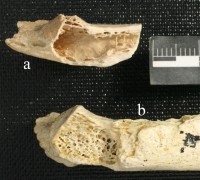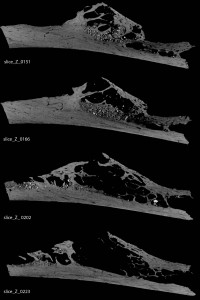 A new study of a 120,000-year-old Neanderthal rib has revealed the oldest human tumor ever found. The rib was first discovered over a century ago in the Krapina rock shelter 35 miles north of Zagreb, Croatia, along with 900 other Neanderthal bones, but it wasn’t until the 1980s when the University of Pennsylvania X-rayed the entire collection that the 30-millimeter (about 1.2 inches) rib fragment stood out in the crowd. It alone among the Krapina bones produced a burned out, overexposed X-ray. A re-examination of the bone using modern imaging technology (high resolution X-rays and microCT scanning) explains why: a fibrous dysplastic tumor had left a cavity where a healthy rib has spongy bone.
A new study of a 120,000-year-old Neanderthal rib has revealed the oldest human tumor ever found. The rib was first discovered over a century ago in the Krapina rock shelter 35 miles north of Zagreb, Croatia, along with 900 other Neanderthal bones, but it wasn’t until the 1980s when the University of Pennsylvania X-rayed the entire collection that the 30-millimeter (about 1.2 inches) rib fragment stood out in the crowd. It alone among the Krapina bones produced a burned out, overexposed X-ray. A re-examination of the bone using modern imaging technology (high resolution X-rays and microCT scanning) explains why: a fibrous dysplastic tumor had left a cavity where a healthy rib has spongy bone.
Fibrous dysplasia is not cancer. It’s a genetic mutation that causes benign tumors to replace the medullary cancellous bone (aka the spongy bone, so called because it’s peppered with holes for blood vessels) with soft fibrous tissue. They can be entirely innocuous, so small that their host doesn’t even know they’re there, or they can be large enough to cause weakness and pain. The large size of the lesion in the Krapina rib (24mm long, 16mm wide and 10mm deep) suggests that the tumor would have been painful.
 It’s a significant find because tumors are rare in the archaeological record. They occur relatively rarely to begin with, often developing with age. Since people live a lot longer now than they did in antiquity and pre-history, archaeological tumors are even rarer. When you go 100,000 years back, the chances of finding a tumor in the fossil record are vanishingly rare because bones are found in fragments, as was this one. Out of the 900 or so Krapina bones, only a few of them are articulated and whole. It was sheer luck that that one inch of rib just happened to be the inch containing a fibrous dysplasia lesion.
It’s a significant find because tumors are rare in the archaeological record. They occur relatively rarely to begin with, often developing with age. Since people live a lot longer now than they did in antiquity and pre-history, archaeological tumors are even rarer. When you go 100,000 years back, the chances of finding a tumor in the fossil record are vanishingly rare because bones are found in fragments, as was this one. Out of the 900 or so Krapina bones, only a few of them are articulated and whole. It was sheer luck that that one inch of rib just happened to be the inch containing a fibrous dysplasia lesion.
The frequency of neoplastic disease is strongly correlated with the relatively recent expansion of the human life span. This increases the frequency of neoplastic diseases, many of which are age-dependent. Neandertals had average life spans that were at best half those modern populations, especially of people in developed countries. Finally, it is recognized that environmental changes wrought by humans, compounded by population expansion, have resulted in an increase the types and the intensification of the pollutants within the environment, many of which are directly associated with neoplastic disease and were not part of environments in the past.
Given these factors, most argue that cases of neoplastic bone disease are rare in prehistoric human populations. It is against this background that the identification of a 120,000+ year old Neandertal with a primary osteolytic lesion is surprising and one that provides insights into the nature and history of the association of humans to neoplastic disease.
The oldest tumors known before now have been found in Egyptian mummies and are around 4,000 years old. That cool Roman teratoma with the teeth in it is 1,600 years old. This tumor beats the Egyptian ones by more than 100,000 years.